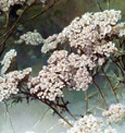| Latin Name | Achillea millefolium Linn. (Asteraceae) |
| English Names | Yarrow, Milfoil |
| Hindi Names | Biranjasipha, Gandana |
 History: Different species of Achillea have been used medicinally from an early date. Dioscorides mentions it as a plant which was used as an astringent and emmenagogue. According to Phing, the origin for the generic name for these plants goes back to the mythical figure, Achilles, who made use of them as a vulnerary. A species of Achillea is the Kaisum of the Arabians. The same plant is the Biranjasib or Biranjasif of the Persians. Another Persian name for the plant is Bu-I-maderan; it is in common use as a tonic in Persia and Sind. In Egypt a species of Achillea is used medicinally under the name of Barbara. In Europe and in the East plants belonging to this genus have long been considered to have stimulant, tonic, emmanogogue and antihemorrhoidal properties. At Engadine, in Switzerland, a volatile oil is extracted from it called Espirt d’Iva. Distribution: Commonly distributed in the Himalayas from Kashmir to Kumaun, at altitudes of 1,050-3,600 m; it has also been seen growing in the Bombay and Belgaum areas. Habit: An erect, slightly aromatic, pubescent, perennial herb with stoloniferous roots. The leaves are oblong- lanceolate, 3-pinnatisect and minutely divided; flower heads are in corymbose clusters with white or pale pink flowers; the achenes are oblong, flattened and shining. The pappus is absent. Principle constituents: The herb contains the alkaloid achilline and also yields an essential oil. Indications: The herb is considered astringent, tonic, diaphoretic, vulnerary and styphic. It has shown excellent results in the treatment of influenza and heavy chest colds and is much used in blood-purifying compounds. Product range: Bonnisan, Geriforte, Liv.52 |
|